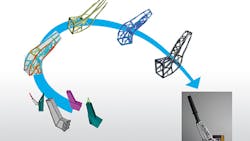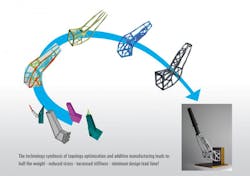3D-Printed Aluminum Antenna Support May Be Space-Bound
Similar to the consumer world, more industrial manufacturers are catching onto 3D printing. One recent example arose from a collaborative effort that leveraged additive manufacturing to enhance an Earth observation satellite antenna.
A collaboration between Altair, EOS, and RUAG Space utilized topology optimization and 3D printing to create an aluminum support that could achieve optimized weight and stiffness performance characteristics not possible through conventional manufacturing techniques. The component is currently undergoing intensive qualification tests.
Design tools used in the project included Altair’s HyperWorks solver Optistruct and solidThinking Evolve to help guarantee a load-sufficient material distribution and meet the necessary design parameters in four weeks. EOS handled the manufacturing of the aluminum components, with the antenna about 40 cm long—reportedly one of the longest metal components ever produced using the powder-bed manufacturing method.
To construct the metal 3D print, built-up layers of powder were joined together to form the desired shape via automated laser sintering. The process results in a much lighter component, which provides satellite engineers with greater design freedom and lowers costs.
The team hopes that the antenna support will be equipped on future Sentinel-1 satellites and that its development isn’t a “one-off” idea. Further space applications for industrial 3D-printed components could include entire satellite structures—meaning that components like electrical harnesses, reflectors, and heating pipes (which still must be manufactured individually) could be integrated into standard 3D-printed structural elements.
About the Author
Iliza Sokol
Associate Digital Editor
Iliza joined the Penton Media group in 2013 after graduating from the Fashion Institute of Technology with a BS in Advertising and Marketing Communications. Prior to joining the staff, she worked at NYLON Magazine and a ghostwriting firm based in New York.

